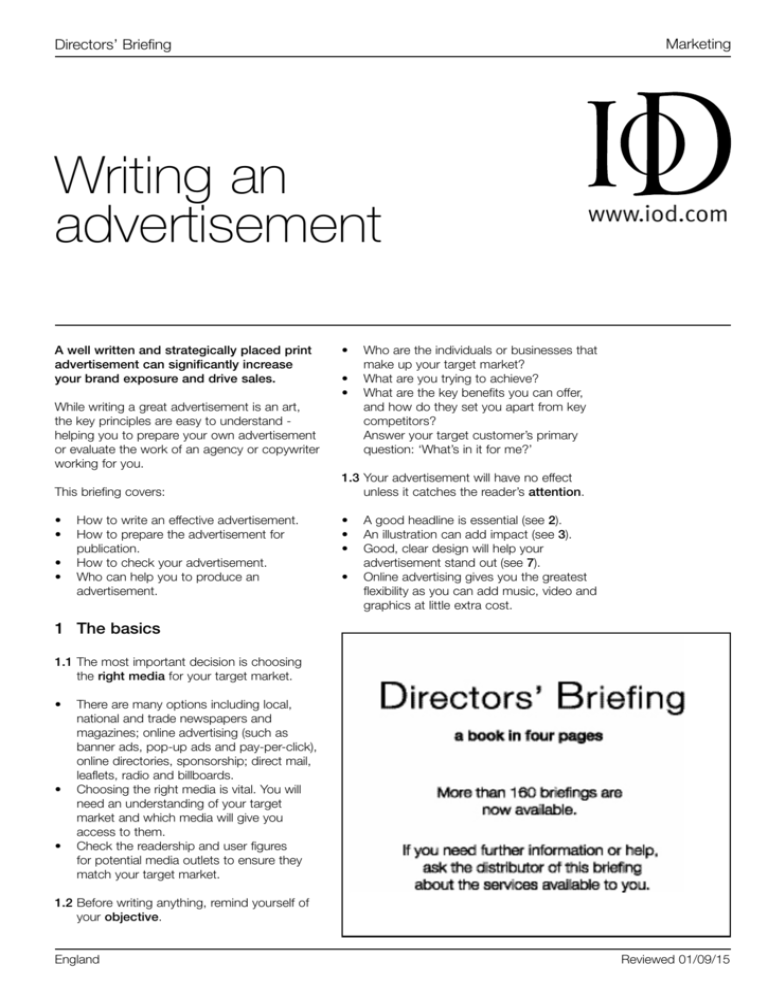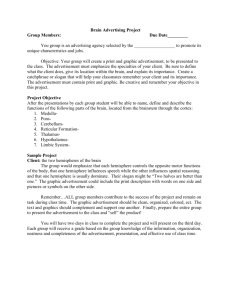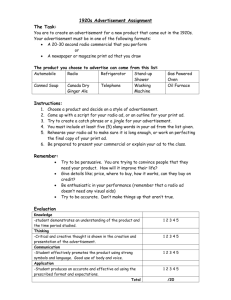
Marketing
Directors’ Briefing
Writing an
advertisement
A well written and strategically placed print
advertisement can significantly increase
your brand exposure and drive sales.
While writing a great advertisement is an art,
the key principles are easy to understand helping you to prepare your own advertisement
or evaluate the work of an agency or copywriter
working for you.
This briefing covers:
• How to write an effective advertisement.
• How to prepare the advertisement for
publication.
• How to check your advertisement.
• Who can help you to produce an
advertisement.
• Who are the individuals or businesses that
make up your target market?
• What are you trying to achieve?
• What are the key benefits you can offer,
and how do they set you apart from key
competitors?
Answer your target customer’s primary
question: ‘What’s in it for me?’
1.3Your advertisement will have no effect
unless it catches the reader’s attention.
• A good headline is essential (see 2).
• An illustration can add impact (see 3).
• Good, clear design will help your
advertisement stand out (see 7).
• Online advertising gives you the greatest
flexibility as you can add music, video and
graphics at little extra cost.
1 The basics
1.1The most important decision is choosing
the right media for your target market.
• There are many options including local,
national and trade newspapers and
magazines; online advertising (such as
banner ads, pop-up ads and pay-per-click),
online directories, sponsorship; direct mail,
leaflets, radio and billboards.
• Choosing the right media is vital. You will
need an understanding of your target
market and which media will give you
access to them.
• Check the readership and user figures
for potential media outlets to ensure they
match your target market.
1.2Before writing anything, remind yourself of
your objective.
England
Reviewed 01/09/15
Directors’ Briefing
1.4Your advertisement needs to carry the
right message.
• After the headline has captured the reader’s
attention, most advertisements use the
main body copy to build up interest, create
a desire for the product and ultimately
prompt the reader to take action.
1.5If the advertisement is meant to generate a
response, make it easy to respond
(see 5).
2 The headline
A compelling headline will draw the eye to your
advertisement, so spend time getting it right.
2.1A good headline will grab the attention of
your target audience.
Good headlines can:
• Highlight the key benefit of your product or
service. For example, expertise, value for
money, convenience, reliability, service, or a
unique selling point.
• Contain news or be topical. For example,
‘Just launched’.
• Arouse curiosity. For example, by raising
a question which the advertisement can
then answer.
• Offer value for money. For example,
‘Children go free’.
• Provide an endorsement. For example,
‘Recommended by dentists’.
2.2Bad headlines will fail to attract attention
and may even put readers off.
• Complicated headlines won’t grab
attention.
• Avoid hackneyed phrases (eg ‘unique
offer’), clichés and claims that cannot
be supported. An empty boast won’t
convince.
• A feature (as opposed to a benefit) of your
product is unlikely to be of interest to your
target market.
For example, when advertising saucepans,
the Teflon coating is less important than the
fact that they are non-stick.
• Avoid jokes as they are unlikely to attract
the right readers and could cause offence.
• Your company or product name may be
interesting to you, but is not necessarily
interesting to your targets.
• Redundant information (eg that you are a
restaurant - when the advertisement will be
appearing in the ‘Restaurants’ section of
the publication).
2
• A misleading headline may encourage
interest - but could be illegal and readers
may feel let down when they find out what
you are really offering.
• Do not put your logo in the headline, as it
stops people reading on. If you include a
logo, put it at the end.
Your final artwork (see 7) should be designed to
make the headline stand out.
3 Illustrations
An illustration acts in much the same way as a
headline. Again, it must capture the attention of
your target market.
3.1A relevant illustration can help your
message to stand out.
• A photograph showing the product in
action, can be very effective.
• A cartoon or line drawings may work in
some publications.
• An experienced photographer or illustrator
can usually come up with good ideas,
and can make even simple products look
interesting.
• A professional stock shot can work well if it
supports the message.
• If you have nothing to illustrate, do not
include illustrations just for the sake of it.
3.2The quality of the illustration will reflect on
your product or service.
• Use a professional who has experience of
your subject.
• Show the photographer or illustrator the
proposed layout for your ad, so they can
come up with a tailor-made image.
• A poor quality illustration will diminish the
impact of your ad and make your product
look cheap.
• To maximise the quality, use black and
white photographs if your advert is to be
printed in black and white.
3.3An illustration will increase your costs.
• You usually have to pay for a photographer
or illustrator, or for the right to use a stock
shot from a picture library.
• If you have to run a colour ad to make your
illustration effective, your advertising costs
could be considerably higher.
4 Body copy
The amount of text your advertisement contains
Directors’ Briefing
will depend on your objectives and your target
market.
For example, advertisements that aim to
increase brand awareness often contain
nothing apart from the headline, an illustration
and the product name.
3
endorsement.
• Giving precise figures, not just
generalisations.
• Backing up any claims you make.
4.3Prompting a response (see 5).
4.4Reinforcing your main message.
In contrast, advertisements in trade magazines
may be packed with facts and details that the
advertiser is confident the reader will want to
know.
Online adverts usually link to a dedicated
landing page on your website and this is where
more in-depth copy should be published. Key
product information and delivery details, as well
as positive customer reviews, can all help to
encourage visitors to buy.
• For example, ending the advertisement
with a pay off line that relates back to
the headline.
Many advertisements repeat the main
offer three times, in different ways, to drive
the message home.
The whole advertisement must answer the
‘What’s in it for me?’ question. Write it from
the reader’s point of view, focusing on benefits
rather than features.
The body copy could include:
4.1Following on from the headline.
Use simple, clear and concise language that
the reader can understand immediately. Break
up paragraphs into easily readable points.
• For example, enlarging on the key benefit.
4.2Supporting your claims with facts.
• Such as providing a third party
Helping hands
A An advertising agency can handle all
aspects of preparing your advertisement.
B A freelance copywriter can write the
headline and body copy.
C A photographer or illustrator can plan
and produce an image or illustration.
D A graphic designer can design your
advertisement and do the artwork.
E A printer can also design and produce
the artwork, although their work may not
be as creative as the work of a graphic
designer.
F The publication the ad will appear in
sometimes offer an ad design service as
part of the package.
Whoever you use, remember to brief them
fully on what you are trying to achieve.
Advertisements should be ‘legal, decent,
honest and truthful’. If in doubt, you can ask
the Committee of Advertising Practice’s Copy
Advice Service (www.cap.org.uk) to check
your ad free of charge.
5 Response mechanisms
5.1If you want readers to respond to a print
advertisement, make it easy for them to do
so.
• Include your company’s contact details:
company name, address, phone number,
email and web address.
• Consider providing a coupon or a
freephone number.
5.2You can prompt readers to respond.
• Provide an incentive, such as a special offer
or discount.
• Give a deadline by which your offer ends.
5.3Devise a response mechanism that will
allow you to measure effectiveness.
For example, ask respondents where they
heard about you.
6 Check your advertisement
Before you design the layout of the
advertisement (see 7), check the content. Look
at it through the eyes of your target customers.
6.1Will the headline (and any illustration) grab
the reader’s attention?
6.2Is the body copy compelling?
• Does it tell readers all they want to know?
➨Advertisements
should be ‘legal,
decent, honest
and truthful’. If in
doubt, you can
ask the Committee
of Advertising
Practice’s Copy
Advice Service
(020 7492 2100 or
www.cap.org.uk) to
check your ad.
Directors’ Briefing
• Are the special benefits of your product
given the emphasis they deserve?
• Is it saying something different from your
competitors’ advertisements?
6.3What effect would the advertisement have?
• Would it achieve your objective?
• Would it make people aware of
your product?
• Would it affect readers’ attitudes towards
your product?
• Would it encourage readers to act?
7 Artwork
7.1Choose clear typefaces (fonts).
• Emphasise important text (eg the headline,
your freephone number) by using large,
bold type.
• Use type that is large enough to be easily
read throughout your advertisement.
• Use a font that reflects the image you want
for your company.
For example, clean, crisp and smart, or
traditional, established and reliable, or
young, stylish and innovative.
• Avoid ornate fonts, which are often difficult
to read.
• Do not mix too many different typefaces in
one advertisement.
• Avoid reversed-out type (white on black) for
large amounts of small print.
7.2Lay out your advertisement with plenty of
white space.
Cramming illustrations and text together
creates clutter, which is off-putting.
• If everything will not fit easily, you probably
have too many words.
7.3Produce final artwork.
4
Will it give the right impression of quality?
• Check a second time to make sure
there are no typographical errors (eg
spelling mistakes, missing text, wrong
typefaces).
• If you are using an illustration, check that
the picture is sharp.
• If your advertisement will be in colour,
check a colour proof.
• Do not let the finished advertisement go out
of the door until you genuinely believe it will
be effective.
Expert
contributors
Thanks to Dee Blick
(The Marketing Gym
Ltd, http://www.
themarketinggym.
org).
If there are errors that are not your fault,
insist that they are corrected at the
publication’s expense.
8 Free help
8.1The Advertising Association has an
extensive website at www.adassoc.org.uk.
• You can download ‘How advertising can
unblock UK growth potential’ (www.
adassoc.org.uk/publications/advertisingpays-2-how-advertising-can-unlock-ukgrowth-potential).
8.2The Committee of Advertising Practice
(www.cap.org.uk) offers free online advice
to help ensure your advertisement complies
with industry rules.
8.3The Institute of Practitioners in
Advertising (or www.ipa.co.uk), the
professional body for advertising agencies,
provides a list of members.
• Its website also offers free guidance on
choosing an agency.
8.4The Advertising Standards Authority
(www.asa.org.uk) is the independent
regulator of advertising across all media.
• Ask the publication what size and format
you must provide your artwork in.
• Check if you need to provide a hard-copy
version of the advertisement.
• Provide any photographs or graphics that
are needed. Identify each photograph on
the back or in the file name.
7.4Check a proof copy of your advertisement
before it goes live or to print.
• Check once, without reading the words, to
see what the overall visual effect is.
Will the advertisement stand out from other
ads appearing on the same page, website
or elsewhere in the same publication?
Published by Atom Content Marketing Ltd, CityPoint, Temple Gate, Bristol, BS1 6PL
Tel: 0117 373 6160, http://atomcontentmarketing.co.uk
© Atom Content Marketing
Ltd 2015. ISSN 1369-1996.
All rights reserved. No
part of this publication
may be reproduced or
transmitted without the
written permission of the
publisher. This publication
is for general guidance
only. The publisher, expert
contributors and distributor
disclaim all liability for
any errors or omissions.
Consult your local business
support organisation or your
professional adviser for help
and advice.






